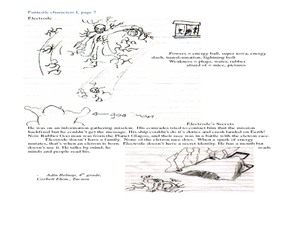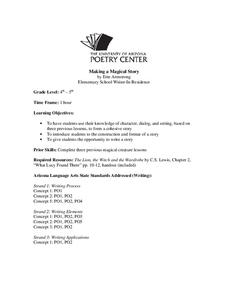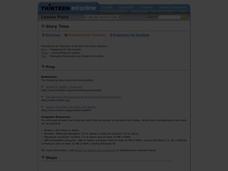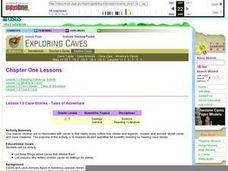Curated OER
Problem/solution
Students examine presentations of problems and reaching solutions in literature. In this writing skills lesson, students read "The Three Little Pigs," and respond to several discussion questions about plot, characters, setting, conflict,...
Curated OER
Arthur's Reading Race: comprehension skills
In this comprehension skills worksheet, students read the book Arthur's Reading Race and complete comprehension activities. Students complete 5 activities including story elements, making inferences, predicting, and drawing conclusions.
Curated OER
Fairy Tales
Once upon a time are four words most children are familiar with when reading a fairy tale. But do they know that fairy tales are a great way to learn the literary elements of reading and writing? Use a thorough fairy tale unit to teach...
Curated OER
Because of Winn-Dixie Scrapbook
Here is a fun resource that your kids will love. While reading the book Because of Winn-Dixie, they analyze the story's main characters by creating an online scrapbook. The purpose is to have them identify character traits and use...
Curated OER
Writing a Book Review
Introduce literary analysis, writing skills, and purposeful reading with a book review. Pupils answer five questions that ask about plot, characters, language used, story elements, and the main character. This is a wonderful way to start...
Museum of Disability
Ian’s Walk and Apples for Cheyenne
Help young learners understand friendship and empathy with two reading comprehension lessons. Each lesson focuses on a story about a child with autism, and encourages readers to compare and contrast the characters to each other and to...
Pennsylvania Department of Education
Analyzing Literary Elements in Fiction
Students analyze the characters and events in fictional writing. In this literary elements lesson, students study the meaning of the words characterization and fiction. They listen to the story Pigsty by Mark Teague, or any other book...
Curated OER
fantastic Characters
Students study stories. In this writing lesson plan, students discuss the three aspects of a story, read stories focusing on the characters, write a story as a class about a character made up by the class, and write a story with an...
Curated OER
Read Aloud- Literary Elements- Prediction
First graders read two stories. In this literary elements instructional activity, 1st graders read The Hat by Jan Brett, notice patterns of prediction, identify the setting, problem and solution and compare the story to the book The...
Curated OER
Story Setting - The Art Lesson by Tomi dePaola
Students read the book The Art Lesson by Tomi dePaola and analyze the story. In this setting lesson, students discuss the importance of the setting and how it helps us understand the story. Students answer questions and chart their...
Curated OER
Telling A Story
Students discover that every story has a start, middle and end. In this literature lesson, the teacher models using a picture to show the parts of the story. Students each take a picture and tell a story using start, middle and end.
Curated OER
A Christmas Carol
Second graders examine the life and times of mid-1800s England in Dicken's time. They compare/contrast Christmas today and during Dicken's day, discuss the book's characters, play a game from the 1800s, and read a Reader's Theater...
Curated OER
Picture-Perfect Story Settings
Using common picture books, teachers can help learners develop the setting for their next creative writing projects.
Curated OER
Making a Magical Story
Fourth and fifth graders use their knowledge of developing character, dialogue, and setting to produce an original story. An excerpt from The Lion, The Witch, and The Wardrobe is used as inspiration to get everyone's creative juices...
Curated OER
The "Write" Stuff: Strategies and Conventions for Imaginative Writing
A comprehensive and immersive series of lessons that examines various aspects of story development leads learners into writing a narrative of their own. Writers develop an understanding of the writing process as they use the learning...
Curated OER
Story Time
Ninth graders watch soap operas online. In this English lesson, 9th graders explore the story elements of the soap opera. Students write a journal on their own interpretations of characters.
Curated OER
Story Map
In this story map learning exercise, students read a story and find the different story elements. They fill in the setting, characters, conflict, and climax.
Curated OER
Planning a Story
Have your class write stories. Learners discuss how to create a great beginning, develop a list of characters, and provide a resoulution of a story. There are some aspects of this presentation that could be altered to provide clearer and...
Curated OER
Circular Story Map
In this story elements map activity, students use the blank graphic organizer to plan a story they will write. Students will write a story that takes place in the country they choose to study. Students think of the setting, characters,...
Curated OER
Introducing Literary Elements in Fiction
Identify literary elements in fiction. In this reading comprehension lesson plan, learners read the book Pigsty and record literary elements onto a graphic organizer. They specifically discuss the main characters and events in the text.
Curated OER
Literary Elements: Storytelling Techniques
Students think about what makes a story interesting to read or hear. What kinds of details make a story come to life? How can a storyteller create a feeling of excitement or suspense? What kinds of characters do students like? If anyone...
Curated OER
Cave Stories - Tales of Adventure
Students list three things about caves that interest them and list reasons why writers choose caves as settings for stories.
Emotional & Behavioral Disorders and Learning Disabilities
Narrative Story Elements Matrix
Readers use a story elements matrix to identify the title, setting, characters, point of view, problem, and solution in four narratives. The template could be used to prepare for a compare/contrast exercise.
Curated OER
Story Stew -- Teaching Character, Plot, And Setting
Students examine the story elements of characters, plot, and setting. They identify the story elements from various "ingredients" taken out of a pot, and add their own story element "ingredients" on index cards into the pot.

























